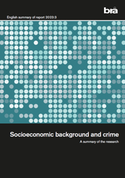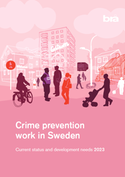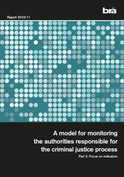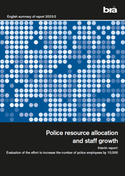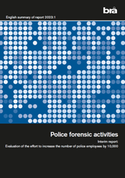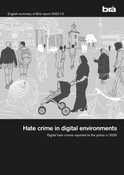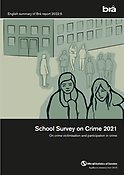Intimate partner violence
Mapping victimisation during 2022 and throughout life. English summary of Brå report 2024:4
This report presents the overall findings on victims of intimate partner violence, both during 2022 and throughout life.
The results are based on a specially designed section of questions regarding different forms of violence by current or former partners. For a separate random sample of 30,000 people, this question section was included in both the digital and paper-form questionnaire for the 2023 Swedish Crime Survey (SCS). Almost 9,200 people chose to participate in the survey, of whom almost 7,000 reported that they currently were, or previously had been, in a romantic relationship which lasted at least one month. The results of this report are based on the responses of these individuals.
Domestic abuse and intimate partner violence
About the study
The report permits the general conclusion that broad parts of society are vulnerable to intimate partner violence. Yet while both women and men are victims of such offences, the results show that women are victims to a greater extent. Women were victimised more frequently during 2022 and are victimised more frequently throughout life. The results also show that, while psychological violence appears to be the most prevalent among both women and men, women are significantly more likely than men to report being subjected to sexual violence by a current or former partner.
Psychological violence, while it is the most common type of violence, is also the least reported to the police. This may be because some of the types of violence included in the category of psychological violence do not necessarily constitute crimes in the legal sense (e.g., being subjected to insults or humiliation). While psychological violence can be harmful, it does not leave physical traces of victimisation in the same way that physical violence can.
The results also show that, rather than report the incident to the police, victims are more likely to seek various forms of support or assistance. The most common reason for not reporting an incident to the police is that the victim does not perceive the incident(s) to be serious enough, although many nevertheless feel that what happened was sufficiently serious to seek support or assistance. This may also be a sign that victims need support from other authorities, not just the police.
Summary of the results
Victimisation during 2022
In total, 13.6 per cent of the population (aged 16-84) reported being a victim of some type of intimate partner violence during 2022. The share of women who report being victimised is greater than the share of men (15.2 per cent and 11.7 per cent respectively).
Most commonly, victims experience some form of psychological violence (12.9 per cent for women and 10.7 per cent for men), and within this category, being subjected to insults and humiliation is most common.
The share that reports being a victim of physical violence during 2022 was 2.6 per cent of women and 2.0 per cent of men. Within this category, assault was most common, while gross assault and violence with weapons were less common.
The share that reports being a victim of sexual violence during 2022 was 4.4 per cent of women and 0.9 per cent of men. Most commonly, victims in this category were subjected to sexual violence through negligence (i.e., a current or former partner having sex with the victim even though the partner should have realised that the victim did not want this).
Younger people are more likely than older people to report being a victim of intimate partner violence during 2022. The greatest share of victims is found in the 20-24 age group.
The share of native Swedes, with at least one Swedish-born parent, who reported being victimised in 2022 was somewhat greater than the share of non-native individuals and native Swedes with two parents born abroad.
Individuals with upper-secondary education report being victimised to the greatest extent, while those with only a primary or lower-secondary education report being victimised to the least extent.
Single parents are significantly more likely than individuals in other family constellations to report being victims of intimate partner violence during 2022. Cohabitants without children are least likely to report being victims of intimate partner violence during 2022.
Residents of socio-economically disadvantaged areas, compared to individuals in socio-economically mixed areas and areas with favourable socio-economic conditions, are somewhat more likely to be victimised.
Recurring victimisation during 2022
The survey defines recurring victimisation as being victimised at least once per month during 2022.
In total, 4.7 per cent of the population (aged 16-84) report experiencing recurring intimate partner violence during 2022. The share of women who report being victimised on a recurring basis is slightly higher than the share of men (5.2 and 4.1 per cent respectively).
The patterns of recurrent victimisation are often the same as when studying total vulnerability to intimate partner violence among everyone during 2022 (i.e., regardless of frequency).
Propensity to report
In total, 2.7 per cent of victims of intimate partner violence during 2022 report that the incident, or one of the incidents during the year, was reported to the police. The share of female victims who report doing so is greater than the share of men (3.5 and 1.4 per cent respectively).
The share reporting that one or more incidents was reported to the police is highest among victims of sexual violence, followed by physical violence, and is lowest among victims of psychological violence.
People in the age groups 16-24 and 25-44 are slightly more likely to state that a police report was made, compared to older people (age groups 45-64 and 65-84).
The main reason, among both male and female victims, for not making a police report, is feeling that what occurred was not serious enough to report it to the police (40.6 and 33.9 per cent respectively). Other common reasons given included that the person has apologised or shown remorse, that it would not be possible to prove it anyway, and that the victim did not know or consider, at the time, that what had happened was a crime.
Need for support or assistance
In total, 16.4 per cent of victims of intimate partner violence during 2022 reported seeking some form of support or assistance as a result of the incident or one of the incidents. Women are more likely to have sought support or assistance than men (19.2 per cent and 11.9 per cent respectively).
The share of victims seeking support or assistance is greatest among people aged 16-24, and it then decreases with age. In the oldest age group, 65-84 years, the share of people seeking support or assistance is least.
Of those who have sought support or assistance, a majority (81.5 per cent) also report having received some form of support or assistance.
Victims most commonly sought and received support from a psychologist or therapist, followed by adult psychiatry or Child and Adolescent Psychiatry and a support centre or helpline.
In total, 2.9 per cent of female and 2.0 per cent of male victims during 2022 reported that the incident, or one of the incidents, resulted in the victim sustaining physical injuries such that they visited or would have needed to visit a doctor, nurse or dentist.
About one half (49.6 per cent) of victims of intimate partner violence during 2022 reported that they had told someone about the incident or about one of the incidents. Women are more likely than men to have told someone about being victimised (58.1 per cent and 36.1 per cent respectively). Victims are most likely to have told a friend, followed by a family member or relative.
Lifetime victimisation
In total, 28.7 per cent of the population (aged 16-84) reported being a victim of some type of intimate partner violence during their lifetime. The share of women who report being victimised is greater than the share of men (35.3 per cent and 20.8 per cent respectively).
Most commonly, victims experience some form of psychological violence (30.4 per cent for women and 18.6 per cent for men), and within this category, being subjected to insults and humiliation is most common.
The share that reports being a victim of physical violence during their lifetime was 14.6 per cent of women and 6.6 per cent of men. Within this category, assault was most common, while gross assault and violence with weapons were less common.
The share that reports being a victim of sexual violence during their lifetime was 17.6 per cent of women and 2.5 per cent of men. Most commonly, victims in this category were subjected to sexual violence through negligence (i.e., a current or former partner having sex with the victim even though the partner should have realised that the victim did not want this).
People in age group 35-44 report lifetime victimisation to the greatest extent, while the 75-84 age group reports it to the least extent. This pattern is similar for both men and women, and victimisation is higher for women than for men in all but the oldest age group.
The share of individuals who reported being a victim of intimate partner violence over their lifetime was greatest among native Swedes, with at least one Swedish-born parent, followed by native Swedes with two parents born abroad as well as non-native individuals.
Publication facts
Author: Anna Frenzel
© Brottsförebyggande rådet 2024
urn:nbn:se:bra-1191
Report 2024:4



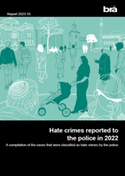
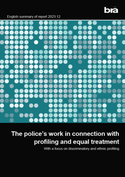
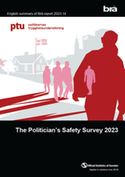
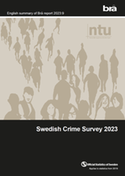
%202023_11_Fraud.png)
